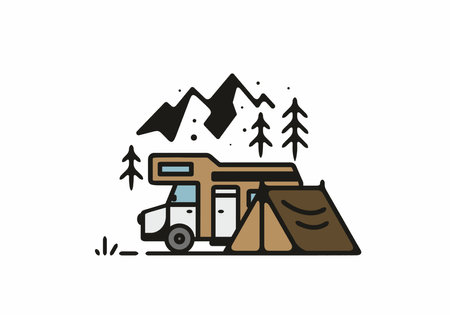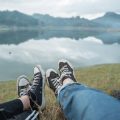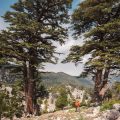1. Location and Accessibility
When choosing your first campsite in the U.S., location and accessibility are two of the most important factors to think about. You don’t want to spend hours on the road only to find out the site is hard to reach or not suitable for your vehicle. Here’s how you can make a smart choice:
Distance from Home
If youre new to camping, its a good idea to pick a spot thats close to home. This way, if anything goes wrong or you forget something important, it’s easier to head back or make a quick store run. Start with a campsite within 1-3 hours of driving distance.
Road Conditions
Not all campsites are located right off the highway. Some may require you to drive on gravel roads or through forested areas. Make sure to check if the roads leading to the campground are well-maintained and suitable for your car, especially if you’re driving a smaller vehicle or dont have four-wheel drive.
Vehicle Access
Many established campgrounds are designed with beginners in mind. They offer:
| Feature | Why It Matters |
|---|---|
| On-site Parking | Makes it easy to unload gear and avoid long walks with heavy bags. |
| Clear Signage | Helps you navigate the area without getting lost. |
| Marked Trails | Keeps hikes safe and beginner-friendly. |
Established Campgrounds vs. Backcountry Sites
If this is your first camping trip, stick with an established campground. These locations usually have amenities like restrooms, picnic tables, and even camp hosts who can answer questions. Backcountry sites may sound exciting, but they require more planning and gear, which can be overwhelming for first-timers.
Quick Tips for First-Time Campers
- Use Google Maps or campground websites to check road conditions before you go.
- Call ahead if youre unsure whether your car can handle the drive in.
- Avoid remote spots until you feel more confident with your camping skills.
Picking the right location makes a huge difference in how much you enjoy your trip. Keep it simple, safe, and convenient for your first time out.
2. Amenities and Facilities
When youre just starting out with camping in the U.S., having access to basic amenities can make your experience way more comfortable and enjoyable. Not all campsites are created equal, so its important to know what features to look for—especially if youre not quite ready to rough it.
Essential Amenities for First-Time Campers
Here’s a breakdown of some key facilities that beginner-friendly campgrounds usually offer:
| Amenity | Why It Matters |
|---|---|
| Restrooms | Flush toilets or clean vault toilets make your stay far more comfortable and sanitary. |
| Potable Water | Having access to safe drinking water means you don’t have to bring gallons from home. |
| Fire Rings | Provides a designated spot for campfires, which is safer and often required by park rules. |
| Picnic Tables | Makes mealtime easier and gives you a place to sit, cook, and relax. |
| Shower Facilities | A nice bonus, especially on longer trips or for those easing into outdoor life. |
Check the Campground Website or Call Ahead
Most U.S. campgrounds list their amenities online, but calling ahead can help clarify whats actually available during your visit. Some sites may have seasonal closures or limited services depending on the time of year.
Tip:
If youre camping in a national park or state park, look for developed campgrounds—theyre more likely to include these creature comforts compared to backcountry or primitive sites.
Amenities Can Make or Break Your First Trip
The right facilities can mean the difference between a stressful weekend and a fun outdoor adventure. So when picking your first campsite, always check what’s included—it’ll help you feel more at home in the great outdoors.

3. Type of Campsite
Before you book your first campsite in the U.S., its important to understand the different types available and choose one that matches your comfort level and gear. Most campgrounds in the United States offer separate areas for tent camping, car camping, and RV camping. Knowing the differences will help you have a more enjoyable experience.
Understanding Your Options
Heres a quick breakdown of the three main types of campsites:
| Campsite Type | Description | Best For |
|---|---|---|
| Tent Camping | Basic site with space for pitching a tent; may include fire pit, picnic table, and nearby restrooms. | Beginners who want a traditional outdoor experience. |
| Car Camping | You park your car at or near your campsite; convenient for bringing more gear and supplies. | Campers who want easy access to their vehicle and some extra comfort. |
| RV Camping | Designated spots for recreational vehicles, often with hookups for electricity, water, and sewage. | Those traveling with an RV or looking for more modern comforts while camping. |
Choose Based on Your Comfort Level
If you’re new to camping and don’t yet own much gear, car camping might be a great place to start—it gives you flexibility without being too rugged. Tent camping is ideal if you’re looking for a back-to-basics nature experience. If you own or are renting an RV, make sure to reserve a spot specifically designed for it, as not all campsites can accommodate large vehicles.
Tip:
When browsing U.S. campground websites like recreation.gov or ReserveAmerica, use filters to search by campsite type. This will help narrow down locations that meet your needs without surprises when you arrive.
Remember:
The right type of campsite can make or break your trip. Think about how much gear youre bringing, how close you want to be to amenities like bathrooms or showers, and whether youre ready to rough it or prefer some creature comforts.
4. Weather and Seasonal Considerations
When choosing your first campsite in the U.S., one of the most important things to look into is the weather and seasonal conditions of the area. The U.S. has a wide range of climates depending on the region, so being aware of what to expect can make or break your camping experience.
Know the Local Climate
Before you book a site, research the typical weather patterns for that region during your planned travel dates. For example, summers in Arizona can be dangerously hot, while springtime in the Pacific Northwest often brings heavy rain. Checking ahead helps you pack appropriately and prepare for any potential challenges.
Seasonal Closures and Hazards
Some campsites are only open during certain times of the year due to snow, flooding risks, or other environmental concerns. It’s also important to check if an area is affected by wildfire risk, especially during dry months in states like California or Colorado.
Common Weather Risks by Region
| Region | Potential Risks |
|---|---|
| Southwest (e.g., Arizona, Nevada) | Extreme heat, flash floods in slot canyons |
| West Coast (e.g., California) | Wildfires, coastal fog |
| Mountain States (e.g., Colorado, Montana) | Sudden temperature drops, snow even in late spring |
| Southeast (e.g., Florida, Georgia) | Heavy rain, hurricanes during summer/fall |
| Pacific Northwest (e.g., Washington, Oregon) | Frequent rain, muddy trails |
Check Conditions Before You Go
Always check the National Park Service website or local ranger stations for up-to-date information about trail closures, fire bans, or severe weather alerts before heading out. Mobile apps like Weather Underground or AccuWeather can also provide real-time updates specific to your campground location.
Pro Tip:
If youre camping at higher elevations—like in the Rockies—remember that temperatures can drop significantly at night even during summer. Bring extra layers just in case!
5. Safety and Regulations
When choosing your first campsite in the U.S., safety should always be a top priority. Understanding local wildlife, fire rules, and campground regulations can make a big difference in how enjoyable and safe your trip will be.
Know the Wildlife in the Area
Different regions in the U.S. are home to different types of wildlife. From bears in national parks to snakes in desert areas, knowing what animals you might encounter helps you prepare properly. Always store food securely—many campsites provide bear-proof lockers or require you to hang your food away from your tent.
Be Aware of Fire Restrictions
Wildfires are a serious concern in many parts of the U.S., especially during dry seasons. Before lighting a campfire, check for any local fire bans or restrictions. Some campsites may only allow fires in designated fire rings or may not permit them at all during certain times of the year.
Follow Campground Rules
Each campground has its own set of rules designed to protect both visitors and nature. These often include quiet hours, pet policies, and waste disposal guidelines. Heres a quick look at some common rules you might come across:
| Category | Typical Rule |
|---|---|
| Food Storage | Use bear-proof containers or lockers; no food left out overnight |
| Pets | Must be leashed at all times; clean up after them |
| Quiet Hours | No loud music or noise between 10 PM – 6 AM |
| Trash Disposal | Pack it in, pack it out or use provided bins |
Tip:
Before heading out, visit the official website of the park or campground to review their specific guidelines. This way, youll avoid surprises and help preserve these beautiful places for future campers.
6. Recreational Activities Nearby
When choosing your first campsite in the U.S., one important factor to consider is the type of recreational activities available nearby. Pick a site that matches what you love to do outdoors—whether its hiking through forest trails, casting a line for some fishing, paddling across calm lakes, or watching the stars light up the night sky.
Many campgrounds in the United States are located near national or state parks, which means youre often just steps away from incredible outdoor adventures. These parks usually offer well-marked trails, scenic overlooks, water access, and designated stargazing areas. Before booking your site, check whats offered nearby so you can make the most of your camping trip.
Common Outdoor Activities and Where to Find Them
| Activity | Popular Regions | Best Time to Go |
|---|---|---|
| Hiking | Rocky Mountains, Appalachian Trail, Yosemite | Spring through Fall |
| Fishing | Great Lakes Region, Pacific Northwest, Ozarks | Spring through Early Fall |
| Kayaking/Canoeing | Florida Everglades, Boundary Waters (Minnesota), Colorado River | Late Spring through Summer |
| Stargazing | Joshua Tree, Big Bend National Park, Bryce Canyon | Year-round (avoid full moon nights) |
Tips for Choosing Based on Activities
- If youre into hiking: Look for campsites near trailheads and elevation maps.
- If you love fishing: Choose sites with lake or river access and check if a fishing license is needed.
- If paddling is your thing: Make sure theres boat or kayak rental nearby if you dont have your own gear.
- If stargazing amazes you: Seek out dark-sky certified parks or remote locations far from city lights.
Selecting a campsite that offers activities you enjoy will make your first camping experience more fun and memorable. Whether youre looking for adventure or relaxation, matching your interests with the right location is key.


